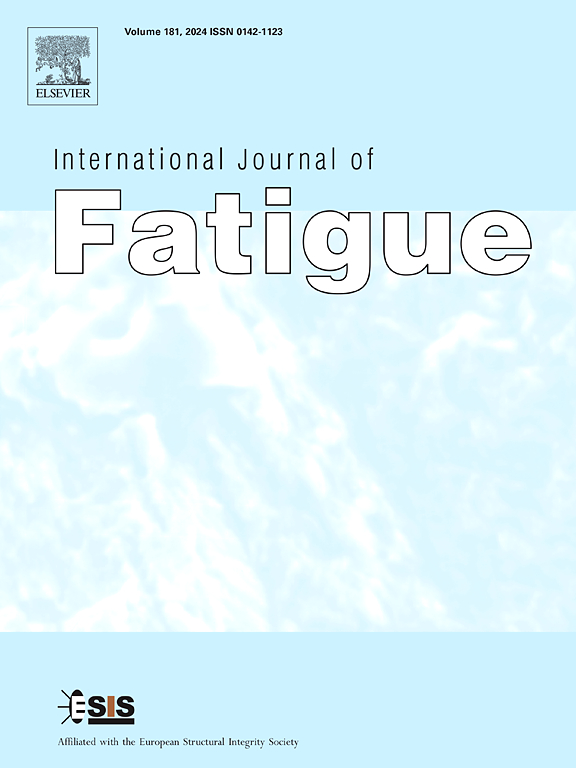Enhanced high-cycle fatigue behavior of electrodeposited nickel plates with optimized grain-size gradient structures
IF 5.7
2区 材料科学
Q1 ENGINEERING, MECHANICAL
引用次数: 0
Abstract
Gradient structures fabricated using plastic deformation methods have been demonstrated to exhibit excellent fatigue performances. However, achieving an optimal gradient structure remains challenging because of methodological limitations. In this study, nickel plates with varying grain-size gradient structures (GSs) were synthesized in a controllable manner via direct-current electrodeposition. Fatigue tests revealed that the GS samples, ranging from coarse grains (CGs, 4 μm) to nano-grains (NGs, 40 nm), exhibited higher fatigue strengths compared to the homogeneous CG sample. Detailed observations showed that cracks were initiated in the surface layers of the GS samples, while severe plastic deformation was mitigated, demonstrating a superior co-deformation capability. An optimized structure with a linear hardness gradient ranging from 2.3 to 3.4 GPa and grain sizes ranging from CGs to ultrafine grains (UFGs, 170 nm) led to a further enhanced fatigue performance, achieving a fatigue limit of 325 MPa and a fatigue ratio of 0.38. This improved performance was attributed to the ability of the structure to disperse cyclic deformation and suppress stress concentration. These findings highlight the potential of controllably synthesized grain-size gradient structures to enhance the high-cycle fatigue properties of nickel plates.
优化晶粒梯度结构提高电沉积镍板的高周疲劳性能
采用塑性变形方法制备的梯度结构具有优异的疲劳性能。然而,由于方法上的限制,实现最佳梯度结构仍然具有挑战性。在本研究中,采用可控的直流电沉积方法合成了具有不同粒径梯度结构(GSs)的镍板。疲劳试验表明,从粗晶(CGs, 4 μm)到纳米晶(NGs, 40 nm)的GS样品比均匀的CG样品具有更高的疲劳强度。详细观察表明,GS样品的表层开始出现裂纹,同时严重的塑性变形得到缓解,显示出优越的共变形能力。线性硬度梯度为2.3 ~ 3.4 GPa,晶粒尺寸为cgg ~超细晶粒(UFGs, 170 nm)的优化结构进一步提高了疲劳性能,达到了325 MPa的疲劳极限和0.38的疲劳比。这种性能的提高是由于这种结构具有分散循环变形和抑制应力集中的能力。这些发现突出了控制合成晶粒尺寸梯度结构以提高镍板高周疲劳性能的潜力。
本文章由计算机程序翻译,如有差异,请以英文原文为准。
求助全文
约1分钟内获得全文
求助全文
来源期刊

International Journal of Fatigue
工程技术-材料科学:综合
CiteScore
10.70
自引率
21.70%
发文量
619
审稿时长
58 days
期刊介绍:
Typical subjects discussed in International Journal of Fatigue address:
Novel fatigue testing and characterization methods (new kinds of fatigue tests, critical evaluation of existing methods, in situ measurement of fatigue degradation, non-contact field measurements)
Multiaxial fatigue and complex loading effects of materials and structures, exploring state-of-the-art concepts in degradation under cyclic loading
Fatigue in the very high cycle regime, including failure mode transitions from surface to subsurface, effects of surface treatment, processing, and loading conditions
Modeling (including degradation processes and related driving forces, multiscale/multi-resolution methods, computational hierarchical and concurrent methods for coupled component and material responses, novel methods for notch root analysis, fracture mechanics, damage mechanics, crack growth kinetics, life prediction and durability, and prediction of stochastic fatigue behavior reflecting microstructure and service conditions)
Models for early stages of fatigue crack formation and growth that explicitly consider microstructure and relevant materials science aspects
Understanding the influence or manufacturing and processing route on fatigue degradation, and embedding this understanding in more predictive schemes for mitigation and design against fatigue
Prognosis and damage state awareness (including sensors, monitoring, methodology, interactive control, accelerated methods, data interpretation)
Applications of technologies associated with fatigue and their implications for structural integrity and reliability. This includes issues related to design, operation and maintenance, i.e., life cycle engineering
Smart materials and structures that can sense and mitigate fatigue degradation
Fatigue of devices and structures at small scales, including effects of process route and surfaces/interfaces.
 求助内容:
求助内容: 应助结果提醒方式:
应助结果提醒方式:


